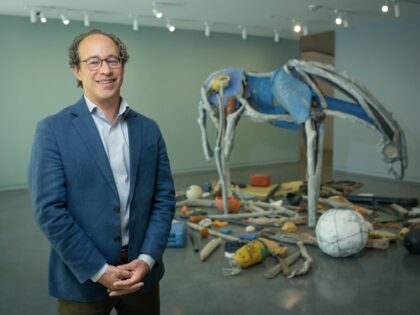
Image: Deborah Butterfield, Three Sorrows (quake, tsunami, meltdown from Gretel Ehrlich’s Facing The Wave), 2016. Tia Collection, Santa Fe, NM. Image courtesy of the artist and LA Louver, Venice, CA.
Recent destructive storms in California shone a spotlight, once again, on how vulnerable our communities are to the forces of nature. When we consider other “unusual” natural events occurring across the country and the globe, it raises questions about humankind’s role in creating them. Convergence Zone focuses on the human-planet relationship, featuring artworks by Deborah Butterfield, Ethan Estess, Helen and Newton Harrison, and Jean Shin, the 2022-23 Denning Visiting Artist and artist-in-residence at Stanford School of Medicine’s LaBeaud Lab.
A convergence zone is an atmospheric region where two prevailing winds interact. The air and water flow conditions in convergence zones encourage accumulation, including the amassing of discarded plastics in some regions of the ocean. The artworks in Convergence Zone bring together reflections on the human impact on bodies of water and how the planet responds with a spectrum of natural consequences.
Related program:
Exhibition artist Jean Shin was in conversation with Marci Kwon, Assistant Professor of Art History at Stanford University and co-director of the Cantor Arts Center’s Asian American Art Initiative on May 10 as the 2023 Burt and Deedee McMurtry Lecturer.
Plastic Recycling in the United States
Plastic recycling in the United States peaked at 10 percent in 2014. Since then, plastic trash generation in the U.S. increased to 50 million tons in 2021, and the recycling rate dropped to just 5 percent. What happens to all the discarded plastic that isn’t recycled? Learn more:
5 Gyres Institute Break Free from Plastic Plastic Planet Stanford PSSI waste collection virtual tour The Story of Plastic





